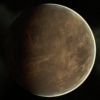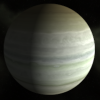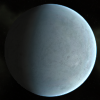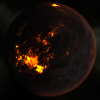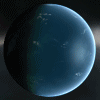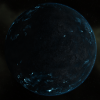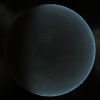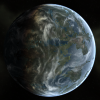Planets
Edit note: Need to add a bullet list to each planet showing what can be made from the resources on that planet without having to ship resources/products in from other planets. Such as Lava being able to make Consumer Electronics
Planets are present in every solar system in EVE. The vast majority are uninhabited. Planetary Interaction introduced in the Tyrannis expansion allows players to utilize the planets in EVE to mine and produce goods in the first step in linking EVE with the upcoming DUST 514.
Contents
Types of planets
There are currently 9 types of planets in EVE, with 8 of them holding resources for Planetary Interaction. Each of those 8 contain 5 different resources and differ in overall planet characteristics. Some types are rarer then others, with the Shattered Planets fewest in number of them all, worthless as far a PI goes (no resources). Resources that only appear on one planet type appear in green
Barren
|
Barren planets are archetypical "dead terrestrials": dry, rocky worlds with a minimal atmosphere and an unremarkable composition. They are commonly etched with flood channels, which are often broad enough to be visible from orbit; most such worlds have accumulated significant quantities of ice over their lifetimes, but cannot retain it on their surface. Generally surface liquid evaporates rapidly, contributing to the thin atmosphere, but occasionally it will seep back into the ground and refreeze, ready for another breakout in future when the local temperature rises. Resources
|
Gas
|
Gas planets are characterized by a deep, opaque upper atmosphere, usually composed primarily of light elements such as hydrogen or helium. Simple chemicals can add a range of hues and shades in the visual spectrum, and the interaction between upwellings and rapidly circulating pressure bands result in a huge variety of visible surface structures. A similar level of diversity can be found beneath the cloud-tops: the inner composition of a given gas planet might belong to any one of a dozen broad groups, with no two planets entirely alike in this regard. Resources
Resources on a Gas planet will typically be found in narrow bands running east-west at various latitudes. Base metals are generally in bands around the equator, Aqueous Liquids and Ionic Solutions in mid-latitudes bands, with the Noble Gas near the poles. Reactive Gas will be found in small pockets at all latitudes. |
Ice
|
The majority of icy planets went through a period of being barren terrestrials, before being surfaced with ice over the course of many millennia. The exact process for this varies from case to case, but the end result is both common and visually uniform - a bright, reflective planet scored by countless fractures and crevasses. A few icy planets are hypothesized to have been warmer, liquid-bearing planets in the past that have subsequently frozen, as a result of either stellar cooling or failed terraforming projects. Resources
Ice planets typically have high amounts of Heavy Metals and Aqueous Liquids available. Micro Organisms and Noble Gas are less abundant, with Planktic Colonies being somewhat thin. Aqueous Liquids tends to be found more in the polar regions of Ice planets, Planktic Colonies in the temperate latitudes and Micro Organisms in the equatorial regions. Noble Gas and Heavy Metals are more randomly distributed with Heavy Metals more towards the equator and Noble Gas more towards the poles but with large areas of overlap and intermingling. |
Lava
|
So-called "lava planets" (properly "magmatic planets") fall into one of three groups: solar magmatics, which orbit sufficiently close to their star that the surface never cools enough to solidify; gravitational magmatics, which experience gravitational shifts sufficiently strong to regularly and significantly fracture cooling crusts; and magmatoids, which are for largely-unexplained reasons simply incapable of cooling and forming a persistent crust. All three types generally exhibit the same external phenomena - huge red-orange lava fields being a defining feature - but the latter two types are sometimes capable of briefly solidifying for a period measured in years or perhaps decades. Resources
Single-Planet Products
|
Oceanic
|
Oceanic worlds are a class of terrestrial world covered entirely by liquids, usually in the form of mundane water. While the liquid surface is exceptionally smooth, the ocean floor on most worlds of this type exhibits significant topographic variety. It is this subsurface irregularity which causes the formation of complex weather systems, which would otherwise revert to more uniform patterns. Resources
|
Plasma
|
The aptly-named "plasma planets" have captured the imagination of countless artists and inspired innumerable works, yet the physics behind them are surprisingly mundane by cosmological standards. A rocky terrestrial with the right kind of atmosphere and magnetic field will, when bombarded with solar radiation, generate sprawling plasma storms as specific atmospheric elements are stripped of their electrons. Over time these storms will generally scorch the surface rock black, adding to the visual impact. Resources
Compared to some other planet types, the resources on Plasma planets tend to be somewhat anemic but evenly distributed across all five types. Unlike Gas planets, there are few guidelines on where you will find concentrations of resources. Distribution of resources is very chaotic. |
Storm
|
Storm worlds are usually considered terrestrial planets, although to a casual eye they may appear more similar to gas planets, given their opaque, high-pressure atmospheres. Geomorphically, however, the distinctions are clear: compared to a gas world, the atmosphere of a storm world is usually considerably shallower, and generally composed primarily of more complex chemicals, while the majority of the planet's mass is a rocky terrestrial ball. Their name is derived from the continent-scale electrical storms that invariably flash through their upper atmospheres. Resources
Storm planets tend to have equal amounts of Aqueous Liquids, Base Metals and Suspended Plasma in decent amounts, with Noble Gas running a close 4th and Ionic Solutions as a distant 5th and somewhat sparse. Ionic Solutions tend to be distributed in the middle latitudes, Noble Gas anywhere but the equator and Suspended Plasma tending towards the equatorial regions. Aqueous Liquids and Base Metals will appear on broad swaths across all latitudes in giant swirling patterns. |
Temperate
|
Life-bearing worlds are often referred to as "temperate", as their mild temperatures are one of their defining features. Planets with existing, stable ecosystems are prime targets for colonization efforts as they are generally easier to make fully habitable; as a result, the majority of highly populated worlds are of this type. Indeed, it is not altogether uncommon for detailed surveys to reveal signs of previous settlements from various stages of New Eden's history. Resources
|
Shattered
Shattered worlds were once terrestrial planets, torn asunder by some immense cataclysm. All such worlds in the New Eden cluster are products of the disastrous stellar events that occurred during the "Seyllin Incident". However, reports continue to circulate of similar planets discovered in the unmapped systems reached exclusively through unstable wormholes. How these met their fate, if indeed they exist at all, is unknown.
Resources
- None
Resource Distribution by Planet Type
Distribution of planet types
| Type | All | HiSec | LoSec | NullSec | W-Space |
|---|---|---|---|---|---|
| 23754 | 3140 | 3199 | 9870 | 7545 | |
| 11251 | 1589 | 1470 | 4690 | 3502 | |
| 8592 | 1407 | 1116 | 3395 | 2674 | |
| 8036 | 1064 | 1032 | 3343 | 2597 | |
| 6939 | 1062 | 912 | 2911 | 2054 | |
| 6473 | 795 | 872 | 2804 | 2002 | |
| 1256 | 171 | 168 | 511 | 406 | |
| 943 | 127 | 131 | 386 | 299 | |
| Shattered | 9 | 0 | 1 | 6 | 2 |
Note: The distribution of planets on the test server, Sisi, was changed on April 27, 2010. So take this information as tentative until it is confirmed when the expansion goes live.
Planets near Aldrat
Handy reference material for interesting planets near Aldrat. If you'd like to help build constellation lists, then simply pick a constellation, post it here, review which planet types exist in the system in-game, and make a table here. Easy!
As for the rarest (useful) planet type, the ![]() Plasma planet, the closest to Aldrat go as follows:
Plasma planet, the closest to Aldrat go as follows:
Hisec
- 3 jumps - 0.9 sec rating - Olbra I
- 7 jumps - 0.6 sec rating - Traun II
- 8 jumps - 0.8 sec rating - Eiluvodi II
- 8 jumps - 0.8 sec rating - Frarn II
Lowsec
- 8 jumps - 0.4 sec rating - Rancer I
- 9 jumps - 0.2 sec rating - Fuskunen II
- 9 jumps - 0.4 sec rating - Atlar I
For finding other planets please refer to http://evemaps.dotlan.net/region/Metropolis/planets. Only shows tranquility data.
Constellation: Aptetter
